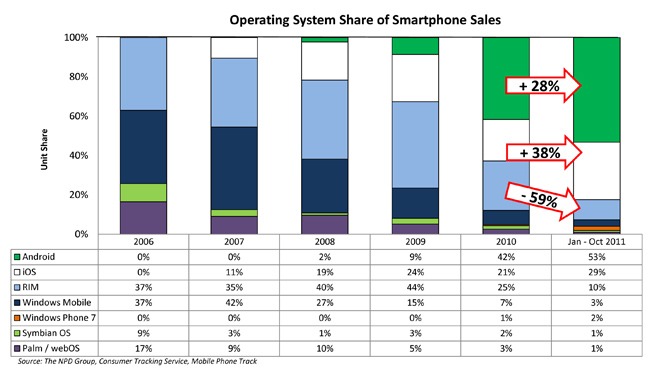Linux OS, with time, is emerging as a fairly popular Operating System.
There was time when Desktop PC was considered to be the major part of the Computers segment. Times have changed, thanks to new powerful Clouds and computing grids, servers now form a big part of the computers.

On Desktop PCs, Windows is still holds the majority, followed by OSX which forms around 10% of the desktop market. But 2011 and 2012 are the years of smartphones and tablets, a domain where Windows has failed to compete with Linux based OS: Android.
In this article, we will cover the Linux Growth rate, Trends, Infographics for recent years.
Best metrics for popularity of an OS are Virus and the Games. Both of them are on the rise for Linux. Lets look at how Linux is doing in each computing segment.
Linux in Desktop PCs
Windows wins here, Linux loses by a large margin. Linux Desktop market share is nearly 0.83% where as Microsoft Windows 7 claims the major share of 42.65% while the other releases of Windows XP and Vista claim 36.44% and 10.88%. However, beyond these numbers, the trend is somewhat bright for Linux. In the beginning of 2011, Linux was only 0.74% which rose to 0.83% by the end of the year. Its slow, but its going up. Same goes for OSX, but windows share is gradually falling.
Linux in Servers
Windows servers lead in the market share over Linux Servers but the trend is shifting towards Linux flavors. First quarter of 2010 in terms of units sold, Windows had a 75.3% market share, (1,379,487 units) compared to 20.8% for Linux (380,429 units) and 3.6% (65,451 units) for Unix.
When it comes to revenue, as you would expect, Windows Server-based systems have an even bigger lead. In the fourth quarter, Windows servers accounted for 48.9% of the market ($5.1 billion), compared to 16.2% ($1.7 billion) for Linux, and 22.2% ($2.3 billion) for Unix.
The truth is, both Windows and Linux will continue to thrive in the server market, and Windows will continue to dominate. Linux fans may like to think they’ll dethrone Windows, but this latest report is one more piece of evidence that’s not likely to happen.
Linux in Mobile devices: Smartphones, Tablets
2011 & 2012 are years of Mobile. People use smartphones more than they use desktops, so it s the most important OS of all.
In nutshell, Smartphone market is divided into Android, iOS or Blackberry. Android is based on the Linux Kernel and is by far the most popular smartphone OS in the world, with Symbian on the steep fall. According to the Global Stat Counter, Android took off with a 13.6% market share in December 2010 and rose to market share of 21.83% by the end of 2011. The numbers speaks for itself, Google is activating 700,000 new devices everyday, this doesn’t include unofficial, non-market android devices.
For iOS its started with 23.57% and went down to 22% of mobile OS share in 2011. Windows is no where to be seen.
Linux has already won over Windows, smartphones alone take Linux market share to be higher than no. of windows PCs. Android is growing with over millions of apps for the OS already available in the appMarket, with 400,000 apps already.

Mobile OS usage:

Though 2011 was another year for iPad, the tech world witnessed some very fine Android Honeycomb devices; namely Samsung Galaxy Tab, ASUS Transformer, ASUS Transformer Prime, Motorola Xoom and ASUS Slider. And in the horde of tablets (about 45 notable tablets) there were only 5 tablets to have Windows OS, and unfortunately all of them failed to find any place in market. Tablets in 2011 aided with Windows OS were HP Slate 500, ASUS Eee Slate, Fujitsu Stylistic, MSI WindPad 110W and Acer Iconia W500.
Here’s an Infographic for Growth of Linux in last 20 years, every milestone detailed:

We write latest and greatest in Tech Guides, Apple, iPhone, Tablets, Android, Open Source, Latest in Tech, subscribe to us@geeknizeron Twitter OR on Facebook Fanpage, Google+:
loading...
loading...

great effort .. i love infographics because of its nature of providing information..
loading...
loading...